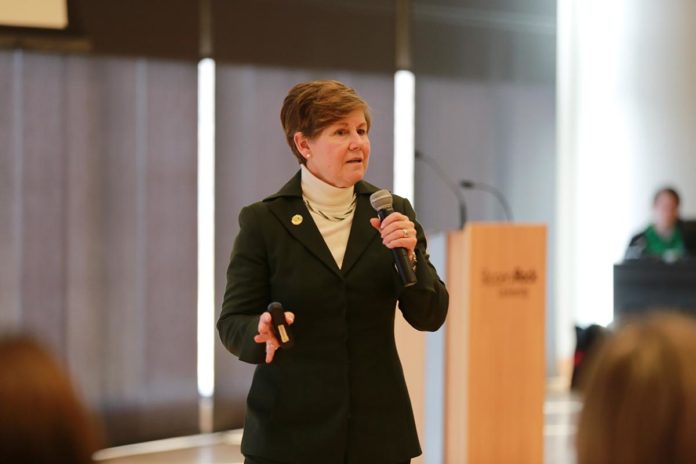President Cheryl J. Norton and several SRU faculty members presented on Tuesday during common hour a compilation of two years’ work called the “strategic plan,” which is a plan highlighting SRU’s main goals to further and establish the university.
Norton said that in late 2014, the strategic planning committee met to discuss the nature of this continual plan.
“[The strategic planning committee] looked at the vision statement of the institution and reaffirmed that this is a vision that we still uphold near and dear and that is that Slippery Rock University will indeed excel as a caring community of life-long learners, connecting with the world,” Norton said. “While the mission statement also had a lot of relevance, they thought it was best if it might be shortened and more refined to clarify our mission without necessarily changing the original intent of it.”
The strategic plan is comprised of eight different goals: to increase enrollment while enhancing student quality and diversity, offer a quality, flexible, agile and integrated curriculum and co-curriculum to develop the intellectual, social, physical and leadership capacities of students, to fuel learning with powerful pedagogies and transformational experiences in and out of the classroom, to maintain an unwavering focus on success for all students, to provide a supportive campus experience through quality housing, dining, recreation, health, safety and administrative services and a caring community, to attract, retain and develop highly qualified and diverse faculty, staff and administrators, increase financial resources, enhance physical facilities, to employ cost-effective technology and use sustainable processes and procedures and to engage alumni and friends in the life of the university.
Norton said that the eight goals are appropriate for Slippery Rock University and will help the institution work in a global society.
“In the summer of 2015, we started taking a more dramatic approach, if you will, to identify how we were going to revise the plan and implement it,” Norton explained. “As a result, team leaders were selected as well as a goal team [steering] committee and together they began to look at the eight goals and define smart goal outcomes.”
Amanda Yale, associate provost of for enrollment management, spoke on behalf of the first goal to and she said that the overall goal is to increase enrollment while enhancing student quality and diversity. She said working to increase enrollment among all of the different types of students, including undergraduate students, graduate students, online students, nontraditional students and international students is key.
“We have increased our high school visits and our college fair visits and secondary markets so we can make even a bigger impact,” Yale said.
Keith Dils, dean of the College of Education, discussed the second goal of offering a quality, flexible, agile and integrated curriculum and co-curriculum to develop the intellectual, social, physical and leadership capacities of students. He explained that a key component of the second goal is providing students with a quality curriculum, which will help students be able to find jobs after graduation and pay off their student loans.
“We have our colleges and our programs positioned to be in strength and thank goodness because our undergraduate enrollment dropped because of things going on with the state budget and things you’ve heard about in the news dealing with education has declined. So undergraduate down, graduate has gone up and if we hadn’t adjusted the curriculum, if we hadn’t been nimble, agile, looking towards high quality, we would not be able to have the position of strength that we are in right now.”
Brad Wilson, interim associate provost of transformational experiences, discussed the third goal of fueling learning with powerful pedagogies and transformational experiences in and out of the classroom.
Wilson said that it is important to acknowledge that the learning process is not a one-way process, thus the third goal is aimed at developing different teaching strategies and approaches.
“In regard to powerful pedagogies, we have realized that the learning process involves effort on the part of both the teacher and the learner,” he said.
Lawrence Shao, dean of the College of Business discussed the fourth goal of maintaining an unwavering focus on success for all students.
Kris Benkeser, director of the Health Center, spoke on behalf of the fifth goal to provide a supportive campus experience through quality housing, dining, recreation, health, safety and administrative services and a caring community.
She said it is important for SRU to offer the best facilities as possible, as the living point is often the turning point when a student is making the decision to commit to SRU.
She also noted the importance of helping students cope with their mental health and teaching students resilience.
Mary Hennessey, assistant to the provost, discussed goal six of attracting, retaining and developing highly qualified and diverse faculty, staff and administrators.
She said that part of the goal is to attract the best faculty, staff and administrators to the university and make sure that SRU is meeting their needs.
John Zeigler, associate provost, information and administrative technology services, discussed goal seven to increase financial resources, enhance physical facilities, employ cost-effective technology and use sustainable processes and procedures.
“We want to take a look at different things like tuition differentials, out of state tuition with our growing online programs,” he said. “We want to look at new non-degree certificates.”
He said that focusing on the “behind the scene” operations will differentiate SRU from other universities.
“We also want to look at sustainable practices,” he said. “We are reducing the consumption of energy on our campus by three percent a year is our goal.”
John Rindy, director of career education and development, spoke on behalf goal eight to engage alumni and friends in the life of the university. Rindy said goal eight is focusing on student success, providing them with more internships and job opportunities.
“I have 2,000 employers in a database in my office right now, 2,000 employers,” Rindy said. “Could they be giving to the institution? Could they be coming to career fairs? Could they be speaking in your classroom, many of them are alums.”
The full strategic plan can be viewed at http://www.sru.edu/about/strategic-planning#sthash.imO2Z6Eb.dpuf.








